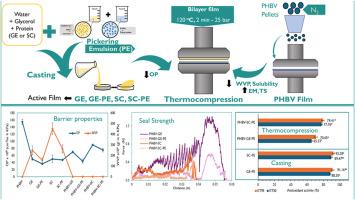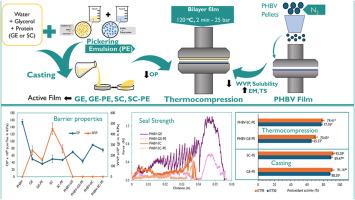Active bilayer films based on poly(3-hydroxybutyrate-co-3-hydroxyvalerate) (PHBV) and proteins containing rutin and carvacrol encapsulated in Pickering emulsion
IF 4.5
2区 化学
Q2 POLYMER SCIENCE
引用次数: 0
Abstract
One strategy to improve the performance of protein-based films is the development of bilayer structures with complementary properties. Poly(3-hydroxybutyrate-co-3-hydroxyvalerate) (PHBV) is a biodegradable biosynthetic polyester that exhibits complementary barrier properties to those of protein-based films. The objective of this study was to obtain and characterize active bilayer films composed of PHBV/gelatin (GE) or sodium caseinate (SC) monolayers films that incorporate rutin and carvacrol in Pickering emulsion (PE). The bilayers were produced by thermocompression. In general, the incorporation of PE in the monolayer films decreased the oxygen permeability (OP) by 27.6 % for GE and 5 % for SC, respectively, which was attributed to an increase in the film tortuosity and provided the films with remarkable antioxidant activity, especially in the less polar simulant. Furthermore, in gelatin films the incorporation of PE also provided them with greater mechanical resistance (increase 29 %) that suggested the presence of significant phenolics-gelatin interactions. Laminating the protein-based films with a PHBV layer conferred the bilayer films with significantly improved water and oxygen barrier properties (0.15 g/m·h·kPa and 70 cm3/m·h·kPa, respectively) and mechanical performance intermediate between those of the respective monolayer films. The PE-loaded bilayer films exhibited enhanced oxygen barrier capacity with a reduction of OP of 16–38 % but with reduced antioxidant activity by ∼19 % compared to the monolayer films. Furthermore, a mild antimicrobial activity against E. coli was observed in the PE-loaded bilayer films. Given this, the bilayer structures demonstrate potential for extending the shelf life of foods and offer a sustainable alternative for active food packaging.


以聚3-羟基丁酸酯-3 -羟基戊酸酯(PHBV)和含有芦丁和香豆醇的蛋白质为基础的活性双层膜包被在皮克林乳液中
提高蛋白质基薄膜性能的一种策略是开发具有互补特性的双层结构。聚(3-羟基丁酸酯-3 -羟基戊酸酯)(PHBV)是一种不可降解的生物合成聚酯,具有与蛋白质基薄膜互补的屏障性能。本研究的目的是在皮克林乳剂(PE)中制备和表征含有芦丁和香芹酚的PHBV/明胶(GE)或酪蛋白酸钠(SC)单层膜的活性双层膜。双分子层是通过热压产生的。总的来说,PE在单层膜中的掺入使GE和SC的透氧性(OP)分别降低了27.6%和5%,这是由于薄膜扭曲度的增加,并使薄膜具有显著的抗氧化活性,特别是在极性较低的模拟物中。此外,在明胶薄膜中,PE的掺入也为它们提供了更大的机械阻力(增加29%),这表明存在显著的酚类物质-明胶相互作用。将蛋白基膜与PHBV膜层合,使双层膜的阻水性和阻氧性能显著提高(分别为0.15 g/m·h·kPa和70 cm3/m·h·kPa),力学性能介于单层膜之间。与单层膜相比,负载聚乙烯的双层膜表现出增强的氧屏障能力,OP降低了16 - 38%,但抗氧化活性降低了约19%。此外,聚乙烯双层膜对大肠杆菌有温和的抑菌活性。鉴于此,双层结构展示了延长食品保质期的潜力,并为活性食品包装提供了可持续的替代方案。
本文章由计算机程序翻译,如有差异,请以英文原文为准。
求助全文
约1分钟内获得全文
求助全文
来源期刊

Polymer
化学-高分子科学
CiteScore
7.90
自引率
8.70%
发文量
959
审稿时长
32 days
期刊介绍:
Polymer is an interdisciplinary journal dedicated to publishing innovative and significant advances in Polymer Physics, Chemistry and Technology. We welcome submissions on polymer hybrids, nanocomposites, characterisation and self-assembly. Polymer also publishes work on the technological application of polymers in energy and optoelectronics.
The main scope is covered but not limited to the following core areas:
Polymer Materials
Nanocomposites and hybrid nanomaterials
Polymer blends, films, fibres, networks and porous materials
Physical Characterization
Characterisation, modelling and simulation* of molecular and materials properties in bulk, solution, and thin films
Polymer Engineering
Advanced multiscale processing methods
Polymer Synthesis, Modification and Self-assembly
Including designer polymer architectures, mechanisms and kinetics, and supramolecular polymerization
Technological Applications
Polymers for energy generation and storage
Polymer membranes for separation technology
Polymers for opto- and microelectronics.
 求助内容:
求助内容: 应助结果提醒方式:
应助结果提醒方式:


